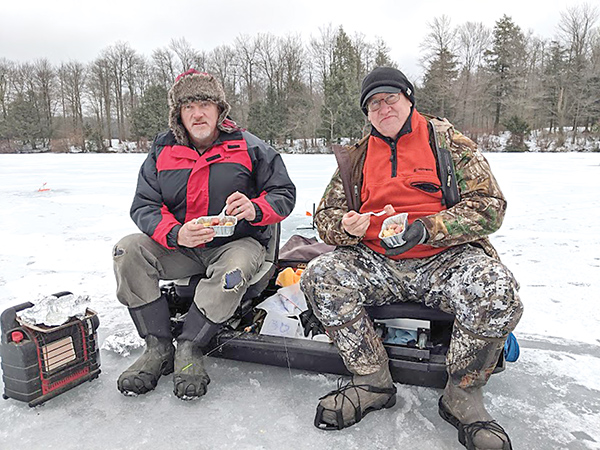Sometimes finding fish through a six-inch hole in the ice is like looking for a needle in a haystack. When fishing a lake that has a solid ice barrier between you and your quarry, your access becomes very limited. That same lake in the summertime allows you to move freely in any direction, and you can cast in multiple directions while moving covering large amounts of water — not so come winter. Once the ice forms, you’re limited to a tiny hole, and even if you drill multiple holes, you are still very limited compared to the open water; thus, locating fish becomes more of a challenge.
There are some lakes where my ice fishing buddies and I go where finding fish is less difficult; we pretty much know where to drill and fish based on past experience. We also know that some lakes are better winter producers than others, but due to poor ice formation this year, we have been limited in our fishing choices.
This past weekend I finally got on the ice, but I had to hit some lakes further to the north that I seldom fish during the winter months. Of course, the first task is to find where the fish are, and as I already mentioned, that can be tough on a frozen lake. Because of the nature of the activity, one tends to become rather sedentary, and it becomes a waiting game; you wait for the fish to swim under your hole and hope they take your offering. Fortunately, that strategy paid off for me last Friday, and I was able to pick up a decent bunch of panfish while working only a few holes.
This past Saturday, some friends and I headed out to a different lake that we haven’t fished in several years. The five of us spread out and set up in different locations near the center of the lake; hours went by without a fish or even a hit.
The question is, “Do you sit in one spot and wait for the fish, or do you frequently move to different locations in hopes of locating active feeding fish”? Some ice fishing enthusiasts advocate for the moving option; I’m just impatient, so I found myself drilling holes in about ten different spots — some in deeper water, and some in water only six feet deep. The roaming around option paid off in this case, and on my third visit to my shallowest hole, I picked up three real nice perch apparently engaged in a feeding frenzy.
For the “Frozen Chosen,” I guess that’s a question we face each time out on the ice, “Do we park ourselves in one spot or do we move about in search of cooperative fish”? Fortunately, these days it’s much easier for an ice fisherman to pick up and move if he so desires. Today’s plastic sleds with pop-up enclosures carry all of our equipment, and they can easily be moved from hole to hole. A lightweight 20-volt drill attached to a six-inch drill bit is easy to carry from one spot to another, and it gets the job done quickly.
The only other “feeding frenzy” I witnessed last week on the ice was a couple of my fishing buddies parked on their ice sleds feeding their faces, which is a good option if the fish aren’t feeding. Tim Herr and Steve Naylor munched on venison hotdogs and tater tots freshly cooked — they even shared with the rest of us. The bottom line is, you can sit in one spot and wait for feeding fish, or you can move about searching for feeding fish or option three — enjoy a good hot meal out on the ice.





Leave a Comment
Your email address will not be published. Required fields are marked with *